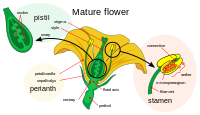
Photo from wikipedia
Simple Summary Data collected from studies in 2020 and 2021 determined that concentrations of chlorantriliprole were detected in the leaves up to 28 days after treatment, were detected in petals… Click to show full abstract
Simple Summary Data collected from studies in 2020 and 2021 determined that concentrations of chlorantriliprole were detected in the leaves up to 28 days after treatment, were detected in petals up to 14 days after treatment, and were not detected in the anthers. Bollworm mortality was determined on leaves, petals, and anthers, with feeding in the field tending to be concentrated on fruiting structures. While bioassay results varied, field results could also be variable in terms of feeding location. Abstract Studies were conducted in 2020 and 2021 at the Delta Research and Extension Center in Stoneville, MS, to determine the residual concentrations of chlorantraniliprole in cotton (Gossypium hirsutum, L.) leaves, as well as the concentrations in petals and anthers that developed after the time of application. Foliar applications of chlorantraniliprole were applied at four rates for leaves and two rates for petals and anthers at the second week of bloom. Additional bioassays were conducted to determine mortality of corn earworm (Helicoverpa zea, Boddie) in anthers. For the leaf study, plants were partitioned into three zones consisting of top, middle, and bottom zones. Leaf samples from each zone were analyzed for chemical concentrations at 1, 7, 14, 21, and 28 days after treatment (DAT). Residual concentrations, although variable, persisted through all sampling dates, rates, and zones tested. In this study, chlorantraniliprole remained detectable up to 28 DAT. Results from the cotton flower petal and anther studies detected concentrations of chlorantraniliprole in petals at 4, 7, 10, and 14 DAT, but no concentrations were detected in anthers. Therefore, no mortality of corn earworm was recorded in the anther bioassays. A series of diet-incorporated bioassays were conducted using concentrations previously found in the petal study to determine baseline susceptibilities of corn earworms and predicted mortality. Results from the diet-incorporated bioassays showed similar susceptibility in field and lab colony corn earworms. Concentrations of chlorantraniliprole could provide up to 64% control of corn earworm when feeding occurs on the petals.
Journal Title: Insects
Year Published: 2023
Link to full text (if available)
Share on Social Media: Sign Up to like & get
recommendations!